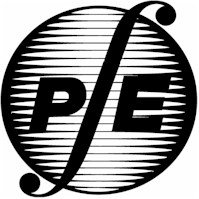Idaho Society of Professional Engineers
Friday Update – 06/15/07
UPCOMING EVENTS:
• July 26 – 29, 2007 –
NSPE 2007 Annual
Conference – Denver, Colorado

JOB OPPORTUNITIES….
Pharmer Engineering, who provides municipal and industrial
water/wastewater consulting and design services, is seeking a
civil/environmental engineer to join its Boise office. The candidate should have
a BS (MS preferred) in civil or environmental engineering or related field.
Minimum 5 years experience in the water/wastewater field is preferred but not
required. Pharmer Engineering offers a competitive benefits package including
health and dental insurance and 401k plan.
Resumes can be sent to Pepi Ursillo at
pursillo@pharmereng.com.
--------------------------------------------------------------------------------
--------------------------------------------------------------------------------
City of Wenatchee
POSITION: CITY ENGINEER
SALARY RANGE: $74,069 - $90,889 annually
GENERAL DUTIES:
This is an administrative management position operating under the general
direction of the Public Works Director - Engineering. The employee occupying the
position is a division manager and is responsible for managing general
engineering operations, “public works” contracts, and the planning, design and
construction of capital and maintenance projects associated with utilities,
streets, and all other city facilities and functions. The Engineering Division
provides engineering services to other city Departments in addition to the
public.
EDUCATION AND/OR EXPERIENCE
• Graduation from a four-year college or university with a degree in
engineering.
• Minimum of five years of previous municipal engineering experience in a
management capacity.
• Knowledge and experience of principles and practices of civil engineering.
• Experience may be substituted for educational requirements.
• Must possess strong management skills.
• Must possess a valid Washington State driver’s license and have a driving
record acceptable to the City’s insurance carrier.
• Registration as a Professional Civil Engineer in Washington State.
TO APPLY: Submit application, resume and cover letter of introduction to:
City of Wenatchee
Human Resource Department
PO Box 519 (129 South Chelan Street)
Wenatchee WA 98807-0519
(509) 664-3303 fax (509) 664-3301
Incomplete application packet will not be considered
CLOSING: 5:00 p.m., Friday, June 22, 2007
--------------------------------------------------------------------------------
POSITION: ASSISTANT CITY ENGINEER
SALARY RANGE: $61,345 - $75,276 annually
GENERAL DUTIES:
Under the general direction of the City Engineer, supervise a variety of
activities related to the design and construction management of City
infrastructure and private development projects. Working independently and with
little direction, supervise and schedule the operation and activities of the
Engineering Division staff through the planning, design, construction, review
and inspection phases of Public Works Capital Improvement projects and
development projects.
EDUCATION AND/OR EXPERIENCE
• Bachelors Degree in Civil Engineering and/or any combination of education and
experience equivalent to high school graduation supplemented by college level
civil engineering courses. Five years of increasingly responsible experience in
civil engineering, including two in project design and construction management.
• Must posses a valid Washington State driver’s license and have a driving
record acceptable to the City’s insurance carrier.
• Required: Registration as a Professional Civil Engineer in Washington State.
TO APPLY: Submit application, resume and cover letter of introduction to:
City of Wenatchee
Human Resource Department
PO Box 519 (129 South Chelan Street)
Wenatchee WA 98807-0519
(509) 664-3303 fax (509) 664-3301
Incomplete application packet will not be considered
CLOSING: 5:00 p.m., Friday, June 22, 2007

SOCIALLY RESPONSIBLE ENGINEERING: JUSTICE IN RISK MANAGEMENT
What does it mean to be a "good" engineer, planner, or design
professional in the ethical sense? Technical professionals must make daily
decisions, which impact upon the quality of life of those who live near the
facilities, plants, structures, and thoroughfares they design, and in the cities
and communities they plan and build. The questions of where these projects are
built, who they are to serve, and how they will affect those who live near them
are at the heart of Socially Responsible Engineering. Written from the
perspective of the engineer, this new resource from two leading engineering
authors is essential to professionals and students who must grapple with how
solutions to engineering problems impact the people those solutions are meant to
serve.
Click here for more information or to order.

MATHCOUNTS PROBLEM OF THE WEEK
Can you solve this MATHCOUNTS problem? The answer will appear in next week's
edition of the Friday Update!
American Flag Day
The United States of America celebrates
the United States Flag on June 14th. Each year many towns across the
United States display US flags on poles along both sides of the length of the
main street through town.
Main Street in Typical
Town, USA is exactly 1.5 miles long. The local boy scout troop has agreed to
place a flag on a pole on each side of the beginning of Main Street and to place
flags every 30 feet to the other end of Main Street. How many flags do they
need to place flags on both sides of Main Street?
--------------------------------------------------------------------------------
The official ratio of the Fly(length) to
Hoist(width) of the rectangular flag of the United States of America is 1.90 to
1.00 as set by Executive Order 10834. There is a list of eleven
permissible specific flag sizes (specified by length and width) for flags
displayed over government agencies: 38.00 × 20.00; 19.00 × 10.00; 17.00 × 8.95;
11.00 × 7.00; 9.50 × 5.00; 5.50 × 4.33; 6.65× 3.50; 4.00 × 3.00; 5.70 × 3.00;
4.50 × 2.37; and 2.50 × 1.32.
Expressing each
ratio as a decimal to the nearest hundredth, how many of these 11 flag
dimensions are in the official 1.90:1.00 ratio?
What is the
range of ratios?
What is the
median ratio?
--------------------------------------------------------------------------------
The ratio of the diameter of each star on the United
States Flag to the hoist is 0.0616 to 1.0000. What is the diameter, in inches,
of each of the 50 stars on a United States Flag that has a fly of 38 inches and
a hoist of 20 inches? Express your answer as a decimal to the nearest
hundredth.
Answer to last week’s MATHCOUNTS problem:
Quadrilateral ABCD is a
square whose side length is 4 units. The area of ABCD is 4 × 4 = 16 square
units. The area of rectangle ABEF is one-half the area of square ABCD. The
coordinates of E are (a, 4). The length of BE is a – 0 = a.
The length of AB is 4 – 0 = 4. The area of rectangle ABEF = 4 × a = 8.
Solving for a, we get a = 2. The equation of the vertical line is
x = 2.
--------------------------------------------------------------------------------
Quadrilateral HIJK is a rectangle whose length (IJ)
is 8 units and width (HI) is 7 units. The area of HIJK is 8 × 7 = 56 square
units. The area of rectangle FIJG is one-half the area of rectangle HIJK. The
coordinates of F are (–2, a). The length of IF is 2 – a.
The length of IJ is 6 – (–2) = 8. The area of rectangle FIJG = 8 × (2 – a)
= 28. Solving for a, we get a = –1.5. The equation of the
horizontal line is y = –1.5.
--------------------------------------------------------------------------------
The area of triangle ABC is one-half the base times
the height. Let BC = 6 be the base. The height of triangle ABC is 10. The
area of triangle ABC is 0.5 × (6×10) = 30 square units. The area of triangle
BDE is one-half the area of triangle ABC. The equation of segment AB is y =
0.4x + 2. Solving for x, we get x = 2.5y – 5.
The coordinates of D are (x, a) and the coordinates of E are (10,
a). BE = (6 – a) and DE = (10 – x) = (10 – (2.5y –
5)) = (15 – 2.5y). Substituting a for y gives (15 – 2.5a).
The area of triangle BDE is 0.5 × (6 – a) × (15 – 2.5a) = 15.
Solve for a. Divide both sides of the equation by 0.5 and 2.5. We then
have (6 – a)2 = 12. Take the square root of both sides and
simplify. a = 6 ± 2√(3). a can’t be 6 + 2√(3) since this value
is too large. The equation of the horizontal line is y = 6 – 2√(3).
If you want to see last
week's problem again, click
http://www.mathcounts.org/webarticles/anmviewer.asp?a=1037&z=110
Idaho Society of Professional Engineers
PO Box 170239
Boise, ID 83717-0239
208-426-0636
Fax: 208-426-0639
E-Mail: ispe@idahospe.org
Web Site: www.Idahospe.org
 Idaho
Society of Professional Engineers
Idaho
Society of Professional Engineers